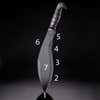7 Reasons Why a Machete is the Only Multitool You Really Need
We may earn revenue from the products available on this page and participate in affiliate programs. Learn more › Photo...

We may earn revenue from the products available on this page and participate in affiliate programs. Learn more ›

Photo by Gorman Studio
If I could have only one tool, it’d be a machete. People around the world have long relied on the machete, kukri (shown here), and other close kin to hunt, fish, farm, build, process food, and fashion all types of tools. Every machete has at least seven smaller tools built into it. Your creativity and practice will unlock the full utility of each, but here’s a start.
1. Point Taken
The point can drill, scrape, open cans and, of course, kill zombies. To skin big game, grip the spine with one hand and use the tip to do the work.
2. Leading Edge
The top of the blade is the machete’s sweet spot. Use it to bushwhack, dispatch game, clear shooting lanes and—if you’re brave and have a steady hand—shave your beard.
3. Middle Relief
The middle third will chop limbs, fell trees, head fish or game, and slice or dice meat. Grip the spine at both ends and push or draw this part of the blade to shape tools, strip bark for rope, or shave tinder or kindling.
4. Fine Touch
The bottom third is short, solid, and easy to control. It’s perfect for precision cutting, making fire sticks, whittling, and sharpening pencils or gigs.
5. Dull Moment
The bottom 2 inches are blunt. This part will hammer, strike fire steel, and open beer bottles. For precision work, move your grip up so your index finger and thumb are here. This shortens the tool and puts your hand at its center, giving you more control.
6. Back to Basics
The spine will scale fish, crack nuts, drive nails, or break off dead limbs. You can also hit the spine with a heavy stick to force the blade to split logs.
7. Flat Top
The flat side of the machete, toward the point, is a basic but effective shovel. And it’ll flip a steak in a pinch.